Type Geologic formation Primary Sandstone | Other shale Named by Meek and Hayden, 1862 | |
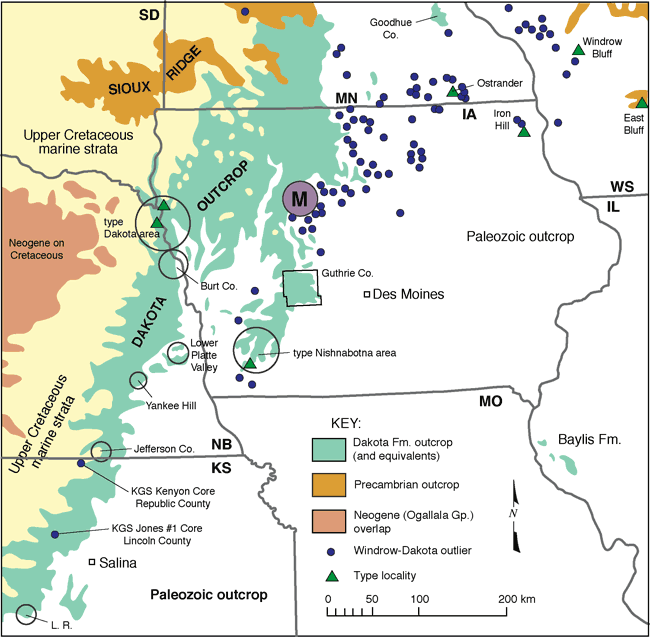 | ||
Region | ||
Dinosaur ridge the bottom of the dakota formation
The Dakota Formation (also Dakota Sandstone and Cockrum Sandstone, more formally the Dakota Group) is a geologic formation composed of sedimentary rocks deposited on the eastern side of the Late Cretaceous Western Interior Seaway. F.B. Meek and F.V. Hayden named it for exposures along the Missouri River near Dakota City, Nebraska.
Contents
- Dinosaur ridge the bottom of the dakota formation
- Geological history
- Two sides of the seaway
- Vertebrate paleofauna
- References
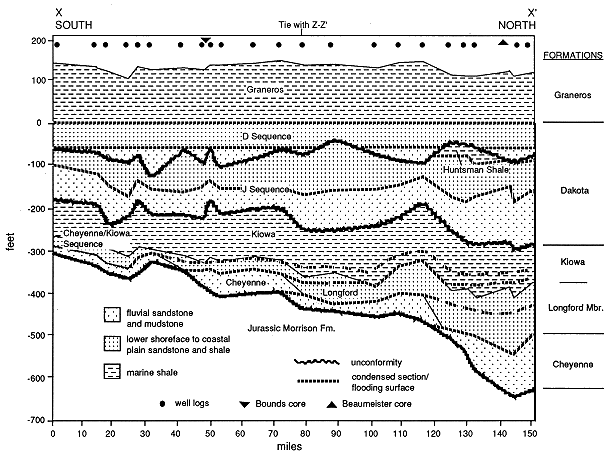
The strata lie unconformably atop Paleozoic and Precambrian rocks, and are the oldest Cretaceous rocks in the northern Great Plains, including Kansas, Nebraska, Iowa, Minnesota, and Wisconsin. It consists of sandy, shallow-marine deposits with intermittent mud flat sediments, and occasional stream deposits.

The Dakota Formation is an important aquifer in some areas of the Great Plains.
Geological history
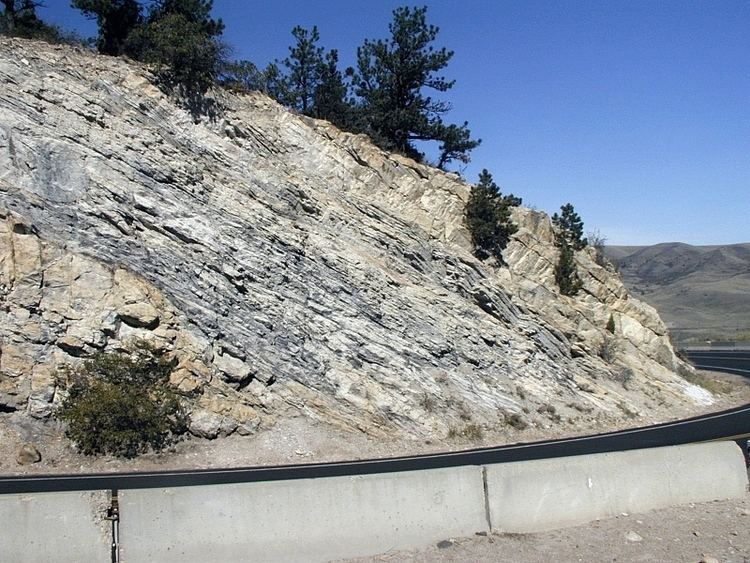
Deposition of the sediments that would become the Dakota Formation began during the early Late Cretaceous (Cenomanian). This deposition marked a reversal from millions of years of erosion. This reversal was due to rising of the mouth of the rivers, called a rise in base level, as the Cretaceous Seaway formed. This rise lowers the gradient of the rivers causing them to deposit sediment because their velocity can no longer sustain high volumes of sediment.
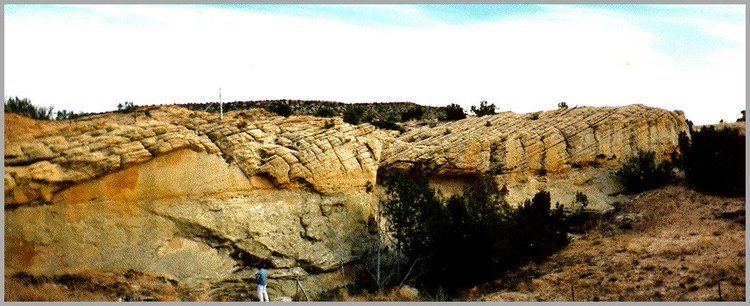
Measurements show that the rivers flowed westward and southwestward towards the encroaching sea from source areas near the present-day Great Lakes. The point of deposition slowly moved eastward as the seaway rose. This change is seen by a gradual shift in the composition of sandstones from having a lot of Paleozoic-age rock detritus in Kansas to sandstones having all Precambrian crystalline rock debris in Iowa.
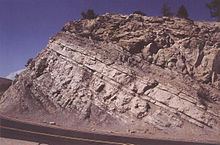
This shift means that the rivers had completely eroded away the Paleozoic rocks in the river source area by the time the Seaway rose high enough for the rivers to deposit sediments in Iowa. The very top of the Dakota Formation was deposited along the coast as indicated by some fossil marine invertebrates. Fossil plants, coal deposits and kaolinite clays show that the climate was warm and wet during deposition of the Dakota Formation. Some of the ancient preserved soils show that an extensive flood plain forest was present.
Two sides of the seaway

Historically, Lower Cretaceous strata in the Rocky Mountain region have been called the Dakota Formation based on assumed correlation with the type section of the Dakota of the Great Plains. Witzke and Ludvigson have argued that use of the name "Dakota" must reflect actual, not presumed correlation based on stratigraphy and composition of the sedimentary rock. To the west of the Rocky Mountains, such as on the Colorado Plateau, this sequence of Upper Cretaceous, predominately sandstone, sedimentary rocks was recommended to be known as the Dakota Group, to dispel any suggestion of direct facies correlation. However, few authors of papers on the Dakota west of the Rocky Mountains, especially on the Colorado Plateau, recognize the Dakota as the Dakota Group, instead using the term Dakota Sandstone, of formation rank. Its subdivisions are recognized as members. Many authors have emphasized the fact that the marine Dakota Sandstone on the Colorado Plateau is intertongued with the marine lower part of the Mancos Shale, resulting in valid lithostratigraphic names such as the Whitewater Arroyo Tongue of the Mancos Shale which is directly overlain by the Twowells Sandstone Tongue of the Dakota Sandstone (references). In the western San Juan Basin, the lowermost part of the Dakota Sandstone, although of marginal marine origin in the eastern San Juan Basin, is a complex of non-marine sandstones. These relationships are especially well displayed in the San Juan Basin of northwestern New Mexico

Beginning in the Early Cretaceous, the Cretaceous Seaway spread south from what is now the Arctic Ocean and connected with a short northward extension from the Gulf of Mexico. This marine transgression of the ocean onto what was formerly land, was completed by the late Albian (~100 MA) thereby dividing North America in half. On the eastern side of the Seaway, sediments that would become the Dakota Formation were deposited as coastal and nearshore marine sands and silts. As the seaway continued to deepen and widen, this eastern shoreline moved progressively eastward throughout the Cenomanian. Meanwhile, on the western side of the seaway, sediments were carried eastwards and northeastwards by rivers from mountains located along what is the Nevada-Utah border.
These western sediments accumulated as nearshore and coastal sands and silts as well, and are counterparts to the Dakota Formation on the eastern side of the Seaway. However, these counterpart sediments originated from the other side of the sea and were carried by rivers flowing in opposite directions. These western sediments are equivalent to the Dakota Formation of the Great Plains, but are not exactly the same strata. Individual formations in the western Dakota Group have local names. In Wyoming, the term Cloverly Formation has been expanded by some authors to include sediments formerly placed within the Dakota Formation. Along the Colorado Front Range, the lower, terrestrial beds, or facies, of the Dakota Group are sometimes called the Lytle Formation, and near-shore marine facies are called the South Platte Formation. In eastern Utah and western Colorado, Young introduced the term Naturita Formation for a series of facies in the larger "Dakota Group". However, despite Witzke and Ludvigson logic, geologist have continued to refer to the Lower Cretaceous sequence of formations on the Colorado Plateau and the Rocky Mountains as the Dakota Group.
Vertebrate paleofauna
Dinosaur fossils are very rare in the Dakota Formation and most of them come from Kansas. Some of them are found in Colorado. The most popular sight for fossils in Colorado is Dinosaur Ridge. The best specimen is a partial skeleton of a nodosaurid ankylosaur called Silvisaurus condrayi. Other isolated ankylosaur material may also belong to Silvisaurus. Fossil dinosaur tracks are also known and include theropod and ankylosaur. A large ornithopod femur is known from Burt County, Nebraska as well as fossil dinosaur tracks from Jefferson County.
